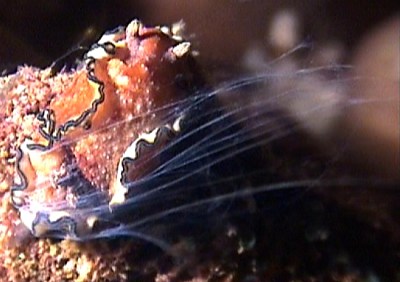
Opisthobranch defence mechanisms
PHOTO
Defensive mantle gland secretions streaming from the chromodorid, Glossodoris cincta. Photo: Danny Van Belle.
With the loss of the shell, opisthobranchs have evolved a whole series of ways of protecting themselves from attack by predators. Here are some of the main strategies.
• Camouflage. One widespread method is to hide from predators by having a colour, shape and/or texture which matches their food or background environment.
• Warning colouration. Many species with bright colour patterns are full of distasteful chemicals. Others with stinging cells or toxic glands have brightly coloured tips.
• Chemical Defence The skin of many many opisthobranchs contains distasteful and sometimes toxic chemicals.
• Behavioural strategies. Many opisthobranchs are mainly active at night when predators are asleep or cannot see them. Others are able to swim for short periods when disturbed, and so escape predators.
Have a look below for some specific areas of interest:
Autotomy
Chemical Ecology
Camouflage
Mimicry
Defensive colouration
Defensive mucus and mantle glands
The aeolid cnidosac
The aeolid cerata
Swimming in opisthobranchs
Sea Hares - chemical defence
Sea Hares - attack & defence, ink glands
References to defensive chemicals in Phyllidiidae
References to Acid Glands & Acid secretions
Rudman, W.B., 2004 (July 27) Opisthobranch defence mechanisms. [In] Sea Slug Forum. Australian Museum, Sydney. Available from http://www.seaslugforum.net/factsheet/defgen
Related messages
-
Which slugs are toxic?
From: Mhairi Todd, February 25, 2005 -
What are their enemies?
From: Debbie Goodman, November 13, 2002 -
Sea slug research
From: Cathy Haynes, October 17, 2000 -
Information on defence in Sea Slugs
From: Aubrey Rogers, April 26, 2000 -
Defence in Sea Slugs?
From: Saeteurn, April 2, 1999 -
Defence in nudibranchs
From: Magdalena Caretti, October 15, 1998 -
Nudibranch Defence Mechanisms
From: Magdalena Caretti, October 14, 1998
